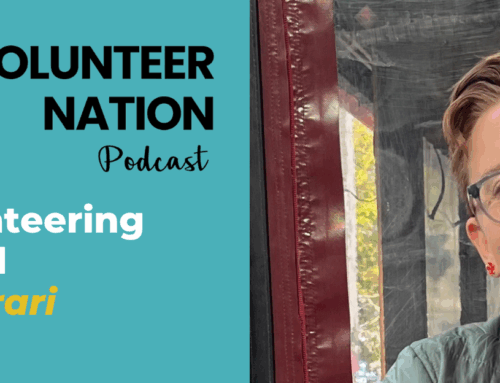Fun Volunteer Teambuilding Activities That Will Keep Your Remote Team Engaged
Many hands make light work, and multi-talented volunteers, working in independent teams, are simply unstoppable.
But how do you make it all work so that you’re not stuck leading? How do you delegate essential tasks to teams and trust that things will get done? How can you weave volunteer teambuilding activities into your meetings if you aren’t able to gather in person?
It can be done!
When provided the proper structure, support and independence, multi-talented volunteer teams can maximize limited organizational resources and scale your impact. But teams need the right environment to thrive. If you are ready to scale your impact, now is the time to foster authentic collaboration that delivers results.
Manage and Support Your Volunteer Team
Before you start thinking about teambuilding activities, it’s important that you consider the best way to manage and support your volunteers.
In 1965, psychologist Bruce Tuckman proposed a model of group development that is composed of five stages: forming, storming, norming, performing and adjourning. Tuckman maintained that these phases are all necessary and inevitable in order for the team to grow, face challenges, tackle problems, find solutions, plan work, and deliver results.
Read on for a closer look at each of the stages.
Stage 1: Forming
In this stage, the individual’s behavior is driven by a desire to be accepted by others and avoid controversy or conflict.
Serious issues and feelings are avoided, and people focus on being busy with routines, such as team organization, who does what, when to meet each other, etc. Individuals are also gathering information and impressions.
This is a comfortable stage to be in, but the avoidance of conflict and threat means that not much actually gets done.
They’ll also be looking to the team leader (you!) for a sense of direction. So, it’s important that you are crystal clear on the team’s purpose, how each individual fits in, and how they will work with each other.
Stage 2: Storming
In this stage, the team addresses issues such as what problems they are really supposed to solve, how they will function independently and together, and what leadership model they will accept.
Team members will start to open up to each other and confront each other’s ideas and perspectives. This is normal and is necessary to the growth of the team! It can be contentious, unpleasant and even painful to members of the team who are averse to conflict.
On the flip side, if confrontations are left unchecked it can lead to a lack of progress, so, ensure you have a conflict resolution plan in place.
In addition, you should model tolerance of each team member and their differences should be emphasized. Without tolerance and patience, the team will fail.
Overwhelm may start to set in during this stage, especially if you and your team aren’t yet clear on what they are responsible for and don’t have a system to manage their time.
Stage 3: Norming
In this stage, team members begin to build mutual understanding, develop shared group norms, and tentatively begin to work together more cohesively.
All team members take responsibility for successes and failures, and have the ambition to work for the success of the team’s goals.
Standards for quality and timeliness of work are well established and the team is in full agreement with project goals.
The danger here is that members may be so focused on preventing conflict that they are reluctant to share controversial ideas.
Team members will respect you as the team leader, so model constructive criticism during team meetings and encourage other teammates to do the same.
Leaders of volunteers can encourage teams to develop better productivity with specific interventions and support at this stage.
Stage 4: Performing
In this stage the team has matured and individuals are able to handle more complex roles. If needed, roles are exchanged and there are processes in place to ensure efficient workflow.
The team members are now competent, autonomous and able to handle the decision-making process without supervision.
Dissent is expected and allowed as long as it is channeled through means acceptable to the team.
This is where empowered leadership reaches its full potential.
Stage 5: Adjourning
In the final stage team members let go of any lingering frustrations with teammates, tasks, etc., and celebrate successes!
Hold a final meeting after completing tasks and reflect on successes and what might change or work better for the next project.
Unfortunately, this also means that since the work is concluded the time to break up the team has come. Don’t just send these committed volunteers loose, though! Transition them to another role or team in your organization.
Now that you understand each of these stages and how you can encourage teamwork along the way, you can help your team become more effective, faster, with volunteer teambuilding activities tailored for each of these stages.
While some teams cruise through these stages with ease, others take time and struggle. Building trust within teams takes work, and team sponsors should be ready to diagnose issues and step in with helpful solutions before the team finds the inevitable conflict untenable.
Also, staff can help normalize the process by preparing teams ahead of time with a review of the Tuckman model. Then, when issues arise, the team doesn’t feel like they are failing.
Creative Volunteer Teambuilding Activities

Leaders can also take steps to integrate relationship building into their development and support of volunteer teams and leaders.
Below are a few ideas.
Use any of these activities during meetings or trainings to build trust and deepen relationships within your volunteer team. These activities can be completed in person, or remotely.
Each volunteer teambuilding activity is aligned with a specific stage of team development to help volunteers move through them successfully.
Forming: The Joy of Six
Objective: To demonstrate the satisfaction of being included and highlight the unease of being excluded
Materials Needed: Messages and envelopes, prepared in advance for all participants
Estimated Time: 10 minutes
Instructions: Choose a short-themed phrase that represents the topic of your meeting or your program. Duplicate the phrase on small pieces of paper and put them in envelopes. If 10 or more people will attend the meeting, make 6 total. If you have less, create less.
Create similar envelopes of 1 to 5 other messages (one unique message per envelope), depending on how many participants you have.
At the meeting, give one envelope to each participant.
Ask participants to open them, and find the other people who have the same message in their envelope.
When everyone has clustered, you will have one group; the rest should be alone.
When they have found anyone who has a similar phrase, ask participants to reflect on the experience and share their thoughts with the group.
Complete this activity virtually: Before the meeting randomly assign each participant one of the phrases. Again, you will want a group of participants to receive the same message, and everyone else to receive something unique. When you kick-off the activity, send every participant an individual message with the phrase. Ask them to find their teammates with the same message. While it’s not as direct as showing separateness in person, the point will still get across! You could also send people into breakout rooms as they find their matches to mimic the feeling of being outcast from the group.
Questions for Reflection:
- How does it feel not to be accepted into a group or team? Has this ever happened to you on the job or when you were volunteering?
- How did you feel when you found someone with the same message?
- How did you feel when you could not find anyone with the same message?
- Did those already in the team reach out to the others? Why or why not? What policies, procedures or self-interests keep us from including others in our teams?
- What can we do to include others “in the loop”?
- What lessons does this have for our own teambuilding?
Storming: I Wish, I Wish
Objective: To unearth unspoken problem areas in a team so that they can be addressed.
Materials Needed: 3 x 5 cards, pens
Estimated Time: 20 minutes
Instructions: Point out the importance of periodically checking on the levels of team cohesiveness, cooperation and member satisfaction. Tell participants that the activity will be one of those periodic check-ups.
Hand out 3×5 cards to everyone, and ask them to write their answers to the following questions on the cards, one per card. (Let them know that they don’t need to sign their names and encourage them to be honest about their experiences.)
-
- If you could change anything about the team’s mission or its way of operating, what would you change?
- If you could change anything about your role on the team, what would you change?
Collect the cards, and group them by theme. Then, ask individuals or small groups (depending on the size of the team) to synthesize the information from one group of cards and report back to group.
Be ready to provide decisions about what may need to change, either during the meeting or in the near future.
After individuals have reported back, ask participants to reflect on the experience and share their thoughts with the group.
Complete this activity virtually: Create an anonymous survey and send the questions to participants ahead of the meeting. Assign small groups based on the themes you receive and send them to breakout rooms to discuss further. Make sure participants have access to the responses by adding them to the meeting agenda. Bring everyone back and share as a group. You could also create a word cloud out of the responses to share with the team as a visual component to gauge where everyone is at.
Questions for Reflection:
- What do you like best about your role and functions on the team?
- If you were king or queen for a day, what would you change about the organization or the team?
- What could we do to make your job better or easier?
- What prevents us from making these changes?
- What might we gain from making these changes?
Norming: How Should We Proceed?
Objective: To help identify team norms, set goals and introduce touchy topics in a fun way.
Materials Needed: Flip chart (or dry erase board) and markers
Estimated Time: 30 minutes
Instructions: Prepare a flip chart with two columns, one with “worst” and one with “best” written above.
Ask participants to call out the best and worst characteristics of teamwork or give examples of good and bad teamwork, behavior in meetings or productivity they have experienced.
Write their answers under the appropriate column (you may need two people to write, if there is a lot of energy).
For each item, ask participants to share their reason for putting it on the list.
Ask participants what actions they can take to be more effective based on the “best” list and a few things they can change or improve upon from the “worst” list.
Develop team norms based on what is identified.
After the group has completed their list of norms, ask participants to reflect on the experience and share their thoughts with the group.
Complete this activity virtually: This activity is already easy to accomplish virtually, just ensure you have your setup figured out ahead of time so that everyone can see the ideas you are writing on the flip chart!
Questions for Reflection:
- Which of the items on the lists do you think the team will have difficulty with?
- Based on this discussion, what topics should we specifically address in future meetings?
Performing: Pipe Dreams
Objective: To inspire creativity in team members.
Materials Needed: Three pipe cleaners per person, prizes
Estimated Time: 10 minutes
Instructions: Before the meeting, place three pipe cleaners at each seat. Unless someone asks what they are for, do not explain until you are halfway through the meeting.
At that time, tell participants that they are free to use the pipe cleaners to make a personal sculpture. Urge them to be creative, and reiterate that they can make anything they want (but, say no more).
At the end of the meeting, ask the team to pick a winner, and give them a prize.
Give special prizes to those who combined their “resources” or used additional items to build something that uses all of their available “tools.”
Take digital photos of the sculptures and post them to remind the team to be creative.
At the end of the meeting, ask participants to reflect on the experience and share their thoughts with the group.
Complete this activity virtually: Mail the pipe cleaners or have your participants pick them up ahead of time. Instruct them to not open the envelope until the meeting starts. Kick off the meeting by letting the participants know that they can now open the envelope. If no one asks questions, don’t say anything more! Follow the rest of the steps above.
Questions for Reflection:
- How curious were you when you saw the pipe cleaners?
- If no one asked their purpose, why not?
- Why did you wait to be told what to do with them?
- Why did most (or all) people work individually? If you worked as a team, who initiated the idea?
- If you didn’t use other materials, why not?
Adjourning: What If …
Objective: To provide an opportunity for team members to prepare contingency plans for potentially disastrous situations.
Materials Needed: Sponge-type or “Koosh” ball, flip chart (or dry erase board) and markers
Estimated Time: 20 minutes
Instructions: After a brief review of brainstorming rules (no critique, quantity not quality, active listening, everyone shares, etc.), tell the group they will get practice handling future problems.
Ask participants to think of a recent experience that featured “Murphy’s Law” (what can go wrong, will go wrong).
Form dyads or triads and ask them to decide on one problem that could go wrong during the course of their project or during implementation.
Start by tossing a ball to one group. Ask the group to present their problem to the larger group, stating it as “what if…?”
Then instruct them toss the ball to another team who must then provide a solution to their question. The team that now has the ball then presents their problem to the larger group, stating it as “what if…?” and tosses the ball to another group who must offer an answer, and so on.
Whichever team catches it must provide one solution no matter how farfetched. Other teams may also chime in after they have shared their solution.
Record the problems and solutions as they are shared on a flip chart and make sure every team has had a chance to share a problem.
Complete this activity virtually: When you form the dyads or triads, put them in breakout rooms for a couple of minutes to discuss a potential problem that might arise and frame it as a “what if…” question. Select one group to kick the activity off and instruct that group to choose another to find a solution to their “what if…” scenario, and so on.
Questions for Reflection:
- What prevents us from seeing our own solutions?
- Why is it we can see solutions to others’ problems so easily?
- What implications does this exercise have for our work?
- How may others react to the “solutions” we have developed during this project? How will they affect others? What do we need to prepare for as we implement them?
These are only a few facilitated activities you might try, based on the specific needs of your team. Also, ask your team members for ideas for volunteer teambuilding activities that they think would be helpful.
Don’t assume volunteers don’t have ideas. Many volunteers have had the benefit of teambuilding within their workplaces. You never know what you might learn.
What Volunteer Teambuilding Activities Will You Try?
Now that you understand how teams form and how you can encourage collaboration every step of the way, which of these activities will you try?
Do you have a favorite activity that you like to lead? Let us know in the comments!
Also, check out our free course for more ideas on how to lead and support volunteers effectively.
Harness the Power of Your Volunteer Team
with our FREE Mini-Course!
One key to leading volunteers is keeping folks engaged.
Enjoying deep engagement and commitment isn’t magic! It takes a smart strategy.
VolunteerPro has a FREE mini-course, The Art & Science of Volunteer Accountability that explains what it takes to be an “architect of experience” and realize success for your volunteer team. In this short lesson, we share how to harness the science of trust for better supervision and deepen connections with volunteers through purposeful strategy.









Leave A Comment